Related Research Articles

Edward Higgins White II was an American aeronautical engineer, United States Air Force officer, test pilot, and NASA astronaut. He was a member of the crews of Gemini 4 and Apollo 1.
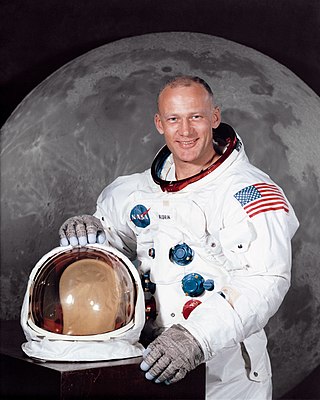
Buzz Aldrin is an American former astronaut, engineer and fighter pilot. He made three spacewalks as pilot of the 1966 Gemini 12 mission. As the Lunar Module Eagle pilot on the 1969 Apollo 11 mission, he and mission commander Neil Armstrong were the first two people to land on the Moon.

Frank Frederick Borman II is a retired United States Air Force (USAF) colonel, aeronautical engineer, NASA astronaut, test pilot, and businessman. He was the commander of Apollo 8, the first mission to fly around the Moon, and together with crewmates Jim Lovell and William Anders, became the first of 24 humans to do so, for which he was awarded the Congressional Space Medal of Honor. As of 2023, he is the oldest living former American astronaut, eleven days older than Lovell.

William Alison Anders is a retired United States Air Force (USAF) major general, former electrical engineer, nuclear engineer, NASA astronaut, and businessman. In December 1968, he was a member of the crew of Apollo 8, the first three people to leave low Earth orbit and travel to the Moon. Along with fellow astronauts Frank Borman and Jim Lovell, Anders circled the Moon ten times, and broadcast live images and commentary back to Earth. During one of the mission's lunar orbits, he took the iconic Earthrise photograph.

Alan LaVern Bean was an American naval officer and aviator, aeronautical engineer, test pilot, NASA astronaut and painter. He was selected to become an astronaut by NASA in 1963 as part of Astronaut Group 3, and was the fourth person to walk on the Moon.

The Robert J. Collier Trophy is an annual aviation award administered by the U.S. National Aeronautic Association (NAA), presented to those who have made "the greatest achievement in aeronautics or astronautics in America, with respect to improving the performance, efficiency, and safety of air or space vehicles, the value of which has been thoroughly demonstrated by actual use during the preceding year."
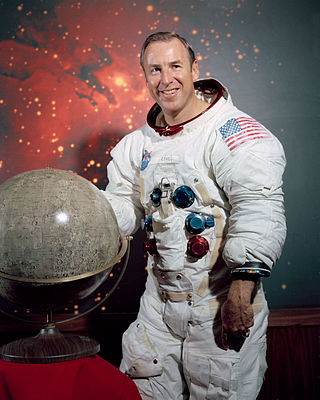
James Arthur Lovell Jr. is an American retired astronaut, naval aviator, test pilot and mechanical engineer. In 1968, as command module pilot of Apollo 8, he became, with Frank Borman and William Anders, one of the first three astronauts to fly to and orbit the Moon. He then commanded the Apollo 13 lunar mission in 1970 which, after a critical failure en route, circled the Moon and returned safely to Earth.
Charles Stark "Doc" Draper was an American scientist and engineer, known as the "father of inertial navigation". He was the founder and director of the Massachusetts Institute of Technology's Instrumentation Laboratory, later renamed the Charles Stark Draper Laboratory, which made the Apollo Moon landings possible through the Apollo Guidance Computer it designed for NASA.

William McMichael "Bill" Shepherd, , is an American former Navy SEAL, aerospace, ocean, and mechanical engineer, and NASA astronaut, who served as commander of Expedition 1, the first crew on the International Space Station. He is a recipient of the Congressional Space Medal of Honor.
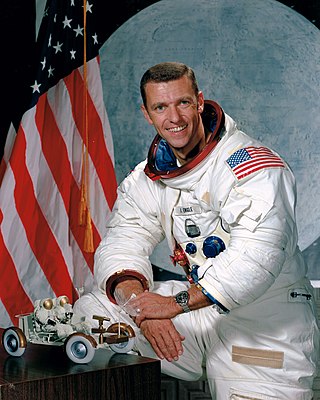
Joe Henry Engle is an American pilot, aeronautical engineer and former NASA astronaut. He was the commander of two Space Shuttle missions including STS-2 in 1981, the program's second orbital flight. He also flew three flights in the Shuttle program's 1977 Approach and Landing Tests. Engle is one of twelve pilots who flew the North American X-15, an experimental spaceplane jointly operated by the Air Force and NASA.

Jack Robert Lousma is an American astronaut, aeronautical engineer, retired United States Marine Corps officer, former naval aviator, NASA astronaut, and politician. He was a member of the second crew, Skylab-3, on the Skylab space station in 1973. In 1982, he commanded STS-3, the third Space Shuttle mission. Lousma was inducted into the United States Astronaut Hall of Fame in 1997. He is the last living crew member of both of his spaceflights.
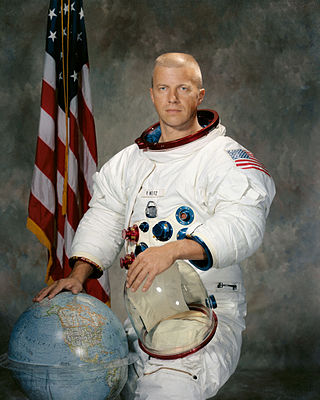
Paul Joseph Weitz was an American naval officer and aviator, aeronautical engineer, test pilot, and NASA astronaut, who flew into space twice. He was a member of the three-man crew who flew on Skylab 2, the first crewed Skylab mission. He was also commander of the STS-6 mission, the maiden flight of the Space Shuttle Challenger.

Owen Kay Garriott was an American electrical engineer and NASA astronaut, who spent 60 days aboard the Skylab space station in 1973 during the Skylab 3 mission, and 10 days aboard Spacelab-1 on a Space Shuttle mission in 1983.

Colonel Gerald Paul Carr was an American mechanical and aeronautical engineer, United States Marine Corps officer, naval aviator, and NASA astronaut. He was commander of Skylab 4, the third and final crewed visit to the Skylab Orbital Workshop, from November 16, 1973, to February 8, 1974.

Edward George Gibson is a former NASA astronaut, pilot, engineer, and physicist.
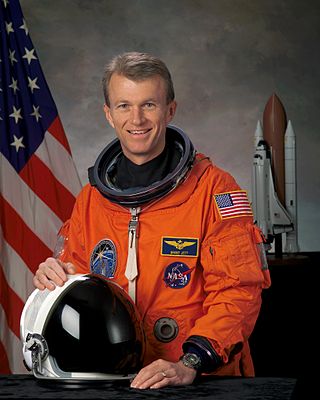
Brent Ward Jett Jr., , is a retired American naval officer and aviator, test pilot, aerospace and aeronautical engineer, and NASA astronaut.
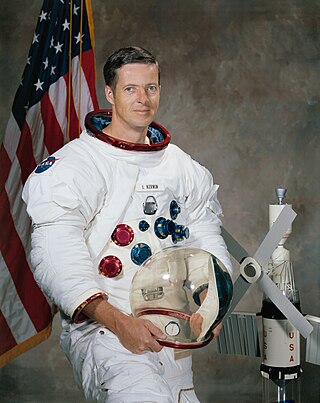
Joseph Peter Kerwin is an American physician and former NASA astronaut, who served as Science Pilot for the Skylab 2 mission from May 25 – June 22, 1973. He was the first physician to be selected for astronaut training. Joe Kerwin was the one who uttered the words during Apollo 13: “Farewell, Aquarius, and we thank you.” Kerwin was inducted into the United States Astronaut Hall of Fame in 1997.
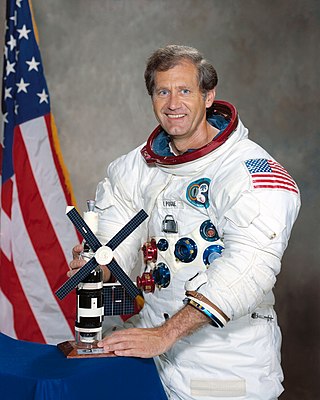
William Reid Pogue was an American astronaut and pilot who served in the United States Air Force (USAF) as a fighter pilot and test pilot, and reached the rank of colonel. He was also a teacher, public speaker and author.

The NASA Exceptional Service Medal is an award granted to U.S. government employees for significant sustained performance characterized by unusual initiative or creative ability that clearly demonstrates substantial improvement in engineering, aeronautics, space flight, administration, support, or space-related endeavors which contribute to NASA programs.
The National Space Club is a non-profit corporation in the US which contains representatives of industry, government, educational institutions and private individuals in order to enhance the exchange of information on astronautics, and to relay this information to the public. It provides scholarships and internships to students, and encourages educational space based activities. The Club promotes space leadership by the United States, the advancement of space technology, and recognizes and honors people who have contributed significantly to the fields of rocketry and astronautics. The Club fulfills these objectives with scholarships, grants, internships, luncheons, the Goddard Memorial Dinner, and newsletters.
References
- ↑ Kluger, Jeffrey (March 29, 1999). "Rocket Scientist Robert Goddard". Time. Archived from the original on October 16, 2007. Retrieved 2010-04-23.
- 1 2 3 4 5 6 7 "Past Goddard Trophy Winners". National Space Club. Archived from the original on 27 May 2022. Retrieved 21 November 2022.
- ↑ "Webb Telescope Team Honored with Robert H. Goddard Memorial Trophy". March 2023.
- ↑ "65th Annual Goddard Memorial Dinner Awardees". Archived from the original on 15 May 2022. Retrieved 21 November 2022.
- ↑ "64th Annual Goddard Memorial Dinner Awardees". Archived from the original on 26 October 2021. Retrieved 21 November 2022.
- ↑ "63rd Annual Goddard Memorial Dinner Awardees". Archived from the original on 17 November 2020. Retrieved 21 November 2022.
- ↑ "62nd Annual Goddard Memorial Dinner Awardees". Archived from the original on 20 July 2019. Retrieved 21 November 2022.
- ↑ "Ford Praises Astronauts, Space Program". Daily Press. Newport News, Virginia. UPI. April 12, 1975. p. 23 – via Newspapers.com.
- ↑ "Astronauts of Apollo 11 to be Feted". The Times. Shreveport, Louisiana. Associated Press. March 6, 1970. p. 10 – via Newspapers.com.
- ↑ "NASA Deputy Moves to Top". Fort Lauderdale News. Fort Lauderdale, Florida. Associated Press. March 5, 1969. p. 2 – via Newspapers.com.